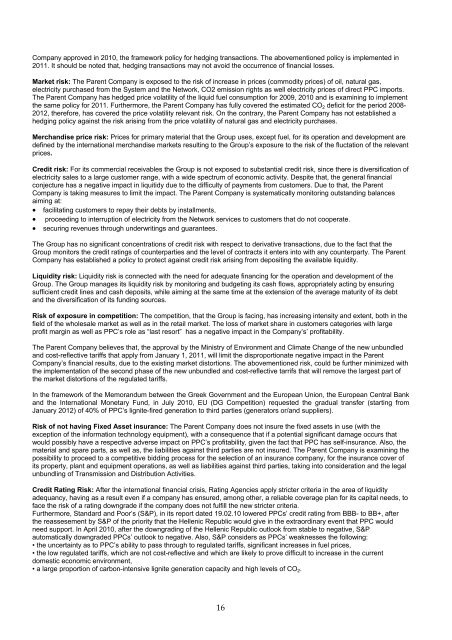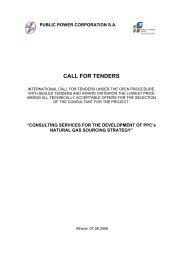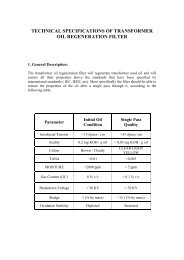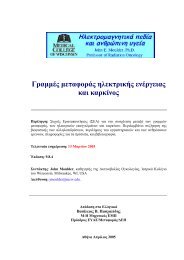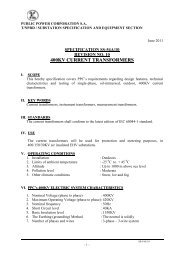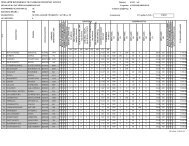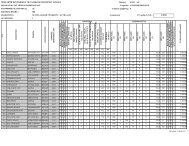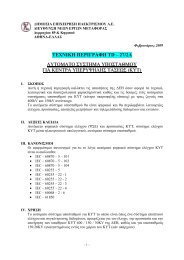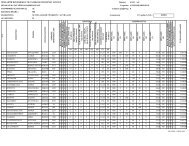Financial Report (January 1, 2010 - December 31, 2010)
Financial Report (January 1, 2010 - December 31, 2010)
Financial Report (January 1, 2010 - December 31, 2010)
You also want an ePaper? Increase the reach of your titles
YUMPU automatically turns print PDFs into web optimized ePapers that Google loves.
Company approved in <strong>2010</strong>, the framework policy for hedging transactions. The abovementioned policy is implemented in2011. It should be noted that, hedging transactions may not avoid the occurrence of financial losses.Market risk: The Parent Company is exposed to the risk of increase in prices (commodity prices) of oil, natural gas,electricity purchased from the System and the Network, CO2 emission rights as well electricity prices of direct PPC imports.The Parent Company has hedged price volatility of the liquid fuel consumption for 2009, <strong>2010</strong> and is examining to implementthe same policy for 2011. Furthermore, the Parent Company has fully covered the estimated CO 2 deficit for the period 2008-2012, therefore, has covered the price volatility relevant risk. On the contrary, the Parent Company has not established ahedging policy against the risk arising from the price volatility of natural gas and electricity purchases.Merchandise price risk: Prices for primary material that the Group uses, except fuel, for its operation and development aredefined by the international merchandise markets resulting to the Group’s exposure to the risk of the fluctation of the relevantprices.Credit risk: For its commercial receivables the Group is not exposed to substantial credit risk, since there is diversification ofelectricity sales to a large customer range, with a wide spectrum of economic activity. Despite that, the general financialconjecture has a negative impact in liquitidy due to the difficulty of payments from customers. Due to that, the ParentCompany is taking measures to limit the impact. The Parent Company is systematically monitoring outstanding balancesaiming at:• facilitating customers to repay their debts by installments,• proceeding to interruption of electricity from the Network services to customers that do not cooperate.• securing revenues through underwritings and guarantees.The Group has no significant concentrations of credit risk with respect to derivative transactions, due to the fact that theGroup monitors the credit ratings of counterparties and the level of contracts it enters into with any counterparty. The ParentCompany has established a policy to protect against credit risk arising from depositing the available liquidity.Liquidity risk: Liquidity risk is connected with the need for adequate financing for the operation and development of theGroup. The Group manages its liquidity risk by monitoring and budgeting its cash flows, appropriately acting by ensuringsufficient credit lines and cash deposits, while aiming at the same time at the extension of the average maturity of its debtand the diversification of its funding sources.Risk of exposure in competition: The competition, that the Group is facing, has increasing intensity and extent, both in thefield of the wholesale market as well as in the retail market. The loss of market share in customers categories with largeprofit margin as well as PPC’s role as “last resort” has a negative impact in the Company’s’ profitability.The Parent Company believes that, the approval by the Ministry of Environment and Climate Change of the new unbundledand cost-reflective tariffs that apply from <strong>January</strong> 1, 2011, will limit the disproportionate negative impact in the ParentCompany’s financial results, due to the existing market distortions. The abovementioned risk, could be further minimized withthe implementation of the second phase of the new unbundled and cost-reflective tarrifs that will remove the largest part ofthe market distortions of the regulated tariffs.In the framework of the Memorandum between the Greek Government and the European Union, the European Central Bankand the International Monetary Fund, in July <strong>2010</strong>, EU (DG Competition) requested the gradual transfer (starting from<strong>January</strong> 2012) of 40% of PPC’s lignite-fired generation to third parties (generators or/and suppliers).Risk of not having Fixed Asset insurance: The Parent Company does not insure the fixed assets in use (with theexception of the information technology equipment), with a consequence that if a potential significant damage occurs thatwould possibly have a respective adverse impact on PPC’s profitability, given the fact that PPC has self-insurance. Also, thematerial and spare parts, as well as, the liabilities against third parties are not insured. The Parent Company is examining thepossibility to proceed to a competitive bidding process for the selection of an insurance company, for the insurance cover ofits property, plant and equipment operations, as well as liabilities against third parties, taking into consideration and the legalunbundling of Transmission and Distribution Activities.Credit Rating Risk: After the international financial crisis, Rating Agencies apply stricter criteria in the area of liquidityadequancy, having as a result even if a company has ensured, among other, a reliable coverage plan for its capital needs, toface the risk of a rating downgrade if the company does not fulfill the new stricter criteria.Furthermore, Standard and Poor’s (S&P), in its report dated 19.02.10 lowered PPCs’ credit rating from BBB- to BB+, afterthe reassesement by S&P of the priority that the Hellenic Republic would give in the extraordinary event that PPC wouldneed support. In April <strong>2010</strong>, after the downgrading of the Hellenic Republic outlook from stable to negative, S&Pautomatically downgraded PPCs’ outlook to negative. Also, S&P considers as PPCs’ weaknesses the following:• the uncertainty as to PPC’s ability to pass through to regulated tariffs, significant increases in fuel prices,• the low regulated tariffs, which are not cost-reflective and which are likely to prove difficult to increase in the currentdomestic economic environment,• a large proportion of carbon-intensive lignite generation capacity and high levels of CO 2 .16


